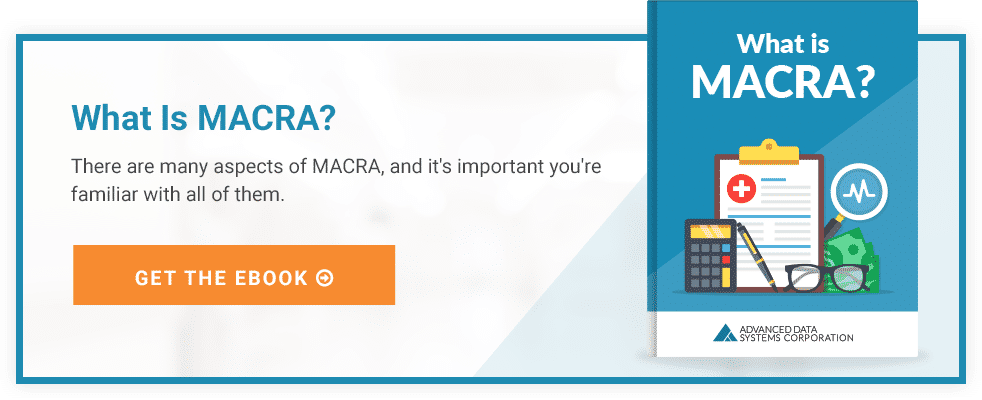Quality in healthcare over quantity of healthcare delivered is the new focus in these United States. In an effort to boost quality, the government is encouraging health care providers to start using Alternative Payment Models (also known as APMs), as part of a broader effort to curb costs and improve efficiency.
These are tall orders, and they are now being pursued by medical organizations large and small as we work toward meeting the goals of MACRA. If you have limited familiarity with the Medicare Access and CHIP Reauthorization Act of 2015 (MACRA), you can gain some insight with our new ebook, “What Is MACRA?” In the mean time, here are answers to the most commonly asked questions that we see about APMs.
1. What’s the Difference Between APMs and Advanced APMs?
A range of Standard Alternative Payment Models or APMs are available for physicians to work with. APMs may be tied to payments per episodes or according to a particular condition. In some cases, there are payment incentives connected with physicians who are providing high-value service (particularly in under served areas) or for meeting specific goals in patient outcomes).
This makes sense, since the government would have a vested interest in giving financial rewards to healthcare providers whose efficiency and improved approach actually wind up costing less while delivering better care, all other things being equal. Physicians who take note of the reimbursements their colleagues are receiving will be therefore encouraged to take part in APMs too. You also have to consider Advanced APMs.
Advanced APMs are different than standard APMs in that they typically involve the participating providers qualifying as a Medical Home Model or shouldering a higher risk of financial burden (they provide more expensive tests, procedures and so on, or deal with a high risk population that needs costlier services in general).
Examples of Advanced APMs include following the Oncology Care Model, the Comprehensive End-stage Renal Disease Care Model and the Comprehensive Care For Joint Replacement (CJR) Payment Model.
Ensure your practice is properly prepared for MACRA. Billions of dollars can be saved by focusing on quality of care rather than quantity.
2. What’s the Difference Between the MIPS and APM Models?
MIPS stands for Merit-Based Incentive System. Medicare and Medicaid clinicians and doctors alike will typically get involved with quality program reimbursements through MIPS.
Be aware that MIPS is broken down in to four categories of performance. The first 50% of the scoring has to do with quality. Advancing Care information makes up 25% of the score. Clinical Practice Improvement Activities account for 15% of the performance scoring, and Cost makes up the remaining 10%, so you can see how variations in your knowledge and abilities can make a difference in these four areas of assessing your performance in patient care.
3. What Are the Benefits of Participating?
You’re already busy with your current duties and may be reluctant to add any more programs and processes to the mix at your medical practice. However, if you consider the benefits, you may be encouraged to participate in APMs.
Participation solidifies the goal that your organization has in delivering higher standards of care going forward. Since we all have to start working more efficiently, it makes sense to start doing it now, with financial incentives being provided to help ensure more adoption amongst medical organizations.
The efforts you engage in now to streamline operations will put you at a competitive advantage. You will be able to do more with fewer resources. It’s possible the additional revenue and boost in efficiency could expand your practice to bring in another specialist or some additional physicians assistants, for example.
4. Who Can Participate?
You can participate if you use a certified Electronic Health Record or EHR application (this is a key aspect of the government’s pursuit of efficiency, as the software will dramatically improve how you and your team function and how quickly you can process patients from waiting room to follow up visits. It’s best to work with an EHR software provider that puts out regular updates, security fixes and other improvements in accordance with evolving industry best practices. Check reviews from respected colleagues to help you determine if the EHR would be a good fit in your organization.
Those who want to participate in an Advanced APM must adopt a Medical Home Model (your medical organization serving as the “home” for patients) or show that you are taking on a higher than normal financial risk in the treatment you provide.
5. Are There Incentives Available?
In addition to regular financial incentives through Medicare/Medicaid, if you participate in Advanced APMs, you may be eligible for a 5% incentive from achieving payment threshold levels or patient levels, which will also exempt you from MIPS requirements for reporting.
6. How do You Participate?
Make sure that your EHR is certified, so that you will be allowed to participate. Your group will need to begin recording data and making reports, such as to demonstrate your quality performance, including information on patients who had to be readmitted after initial treatment. Showing improvement in taking care of patients is part of the reporting requirements if you are going to participate in APMs.
Greater efficiency in healthcare delivery is a crucial goal, and we all have to work together to make medicine available to more people in the U.S. Working with APMs is certainly an important step in that direction.
Key Takeaway:
- The Medicare Access and CHIP Reauthorization Act of 2015 (MACRA) is designed to promote more efficient use of healthcare resources in the United States.
- In support of MACRA, physicians who treat patients under Medicare and Medicaid are using Alternative Payment Models or APMs.
- Another acronym to pay attention to is MIPS, which stands for Merit-Based Incentive Payment System. It was established to advance patient care information and improve clinic outcomes as well as cut costs.
- Financial incentives are available to doctors who participate in APMs.
- Your Electronic Health Record or EHR application needs to be certified in order for your physicians to receive reimbursements from Medicare and Medicaid under APMs.
- Participation in APMs gives you an advantage over practices that do not employ cost and efficiency promoting measures in their own facilities.
These answers to commonly asked questions about APMs and advanced APMs are designed to help you gain a better understanding of MACRA and how your medical organization fits in. With so many moving parts in the healthcare industry as well as on the government side of things, chances are that you will require more information. Stay better informed by coming back to this blog on a regular basis for updates. Until the next post, click here to download our free ebook, “What Is MACRA?”
About Marc Klar
Marc has decades of experience in medical software sales, marketing, and management.
As Vice President of Marketing, Marc oversees the entire marketing effort for ADS (the MedicsCloud Suite) and ADS RCM (MedicsRCM).
Among other things, Marc enjoys writing (he’s had articles published), reading, cooking, and performing comedy which sometimes isn’t funny for him or his audience. An accomplished drummer, Marc has studied with some of the top jazz drummers in NYC, and he plays with two jazz big bands. Marc was in the 199th Army Band because the first 198 didn’t want him, and he has taught drumming at several music schools.
Next: read our ADS and ADS RCM blogs, ebooks and whitepapers. They’ll stimulate your brain as well.




